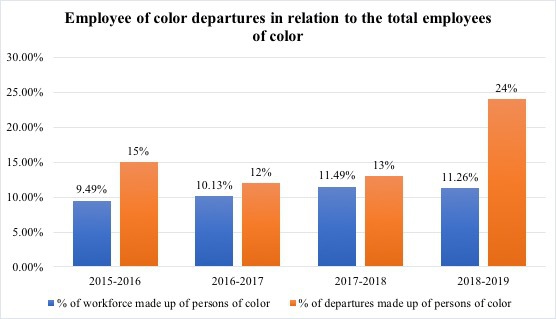Calvin responds to increased departures of employees of color
Calvin has seen a recent increase in the number of employees of color leaving the university. 11 employees of color left Calvin during the 2018-19 school year. This is an increase from seven such departures in the year prior.
Last year’s numbers especially stand out in contrast to five-year trends of decreasing departures among employees of color, which includes both staff and faculty. The 12 employees of color who departed during the 2013-14 school year made up 27% of all departures that year. During the 2016-17 and 2017-18 school years these numbers had decreased to 12% and 13% respectively. Last year’s 11 departures bring that percentage back up to 24%.
The overall percentage of Calvin’s workforce composed of persons of color is only 10.82%, and while this is still up from 9.49% in 2015, it remains lower than the five-year high of 11.49% in 2017.
Michelle Loyd-Paige, executive associate to the president for diversity and inclusion, expressed concern for the number of departures in the past year, especially amidst budget cuts that may make refilling these positions more difficult. She also expressed her excitement at the increased retention rates of the five years prior and stated that overall numbers of employees of color had increased in this time period as well.
Andrew George, director of human resources, referenced exit surveys that showed departing employees were concerned about lack of upward mobility. Promotion processes are different for faculty and staff, and due to the long-term nature of supervisory roles, staff often experience this lack of upward mobility more. Although these limited opportunities for advancement are applicable to all employees, they may often be felt more by employees of color.
Loyd-Paige also expressed that it is not uncommon for persons of color in higher education, especially Christian higher education, to be offered higher or better paying positions at competing universities.
In addition, some of the departures are attributable to retirements, which Loyd-Paige said are cause for celebration, not alarm.
George also offered other possible reasons for departure such as “misalignment with an institution’s vision and strategy” and discontentment with pay, benefits, conflict, and a variety of other factors. Departures can also be for a variety of common reasons that could apply to any employee such as moving to be closer to family.
There are also a number of possible reasons, Loyd-Paige stated, that prospective employees of color may decide against coming to work at Calvin. Included in these reasons are the faculty membership requirements, differences between Calvin’s salaries and what they might make elsewhere due to the university’s lack of a differential payscale and strict budgeting, West Michigan weather, and lack of racial equity in Grand Rapids. Related reporting includes MLive articles on a state probe into complaints of police discrimination and a state hearing on racial discrimination by the GRPD.
These factors are not representative of every candidate’s experience, and often it is a combination of multiple factors that discourage candidates rather than a single one.
Students also want increased diversity and representation among staff and faculty. Opinions vary, however, on the extent to which the college should alter its requirements for faculty membership in order to attract and recruit more faculty of color.
One major point of contention surrounds the requirement that professors be members of the Christian Reformed Church. Some students, like religion major and business minor Andrew Plaisier, think that the university should not waive this requirement, as it is necessary for maintaining Calvin’s identity as a Reformed university.
On the other hand, students like junior Lindsay Owens believe that the CRC membership requirement should be waived as it represents a hindrance to the recruitment of faculty of color. Owens said on the subject, “I think they [Calvin] have these bold aspirations, but perhaps Calvin is going to need to give up part of its identity to meet those aspirations.”
The main argument from students sharing Owens’ perspective seems to be that allowing employees of different denominations and Christian traditions would increase diversity while maintaining a Christian, though not necessarily Reformed, commitment.
To combat deterring factors, Calvin employs a number of measures designed to attract and retain employees of color. George said, “We [Calvin] have well developed recruiting strategies in place but we also continue to consider and develop new ones as we assess our effectiveness.”
Stay interviews are another method that could be used to retain employees. Loyd-Paige described stay interviews as regular meetings with employees to evaluate contentment and identify potential issues. This will allow the university to address issues and increase the contentment of employees before they begin to consider leaving.
George also expressed that the HR department works hard to listen closely to current employees and encourage them to utilize their professional networks to attract new employees. Additionally, the university has begun to use more inclusive language in job postings and increased the number of diversity-based resources for posting jobs.
Calvin’s HR website page states, “At Calvin, we’re building a community of diversity and accessibility. We do not discriminate in the employment of individuals on the basis of race, color, national or ethnic origin, disability, sex or age.”
The university’s current goal, George said, is to have upwards of 20% of the candidate pool for any given job to be made up of diverse candidates.
As it stands, there are concerns among students that this goal is not being visibly met. Khayree Williams, assistant dean for multicultural student development office, stated that “one of the concerns that rises to the top is, ‘why don’t we have more faculty of color?’” He added that, to the people who share this concern, it seems like a contradiction that Christians who are not a part of the CRC are allowed to work at Calvin, but would not be allowed to teach here.
Furthermore, Williams said that the presence of faculty of color is an integral component in retaining students of color, as it’s important for all students to “see faculty members who look like them” — an issue not present for white students.
Williams also added that although the push for more employees of color and conversation about diversity has been around for a while, it’s important that it continues as it will take time for Calvin to meet its goals while retaining its Reformed identity and tradition.
Student perceptions regarding faculty of color at Calvin are nuanced. Sophomore Einstein Essibu said about employee diversity, “I have not had much experience with faculty of color here at Calvin.” This perception of Calvin’s diversity as lacking doesn’t seem to be a primary concern for students, however. Many students made it clear that they have not given the issues surrounding perceived lack of employee representation considerable thought.







